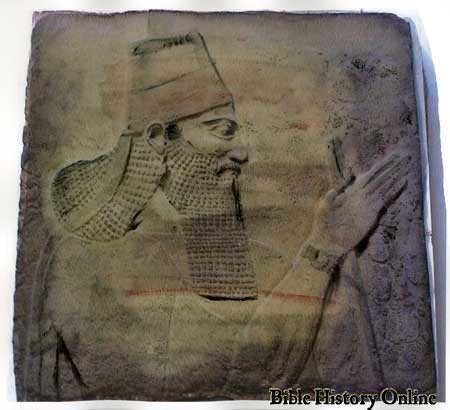Tiglath Pileser III (Pul)

Could this be the same
Tiglathpileser mentioned in the Bible who carried captives of Israel into
captivity?
Tiglath Pileser III (Pul) is seen here in this sculptured tablet from ancient Nimrud, the capital of ancient Assyria during his time.
Tiglath Pileser III (Pul) is seen here in this sculptured tablet from ancient Nimrud, the capital of ancient Assyria during his time. When Tiglath Pileser III ascended the throne of Assyria it was the beginning of the end for the northern kingdom of Israel. The Tiglath Pileser III tablet is an important discovery in Biblical Archaeology because it shows us a portrait of the Assyrian monarch who formed the Assyrian Empire and confirms the Biblical account.
"In the days of Pekah king of Israel came Tiglathpileser king of Assyria, and took Ijon, and Abelbethmaachah, and Janoah, and Kedesh, and Hazor, and Gilead, and Galilee, all the land of Naphtali, and carried them captive to Assyria." 2 Kings 15:29
Interesting Note: There is also an inscription of Tiglath Pileser that says: "Pekah their king they had overthrown, I placed Hoshea over them. From him I received 10 talents of gold and 1000 talents of silver." [This is an exact confirmation of the Biblical account in 2 Kings 15:30 "And Hoshea the son of Elah made a conspiracy against Pekah the son of Remaliah, and smote him, and slew him, and reigned in his stead" and 2 Kings 17:3 "Against him came up Shalmaneser king of Assyria; and Hoshea became his servant, and gave him presents." Tiglath Pileser's inscriptions mention the names of 5 Hebrew kings: Uzziah, Ahaz, Menahem, Pekah and Hoshea. ]
Interesting Note: There is also an inscription of Tiglath Pileser that says: "The people of the land of Omri I deported to Assyria, with their property." [This also is an exact confirmation of the Biblical account. It says in 2 Kings 15:29 "In the days of Pekah king of Israel came Tiglathpileser king of Assyria, and took Ijon, and Abelbethmaachah, and Janoah, and Kedesh, and Hazor, and Gilead, and Galilee, all the land of Naphtali, and carried them captive to Assyria."]
Detailed Description of the Tiglath Pileser III Relief
Material - Plaster Tablet
Upper Fragment
Neo Assyrian
Date: 745-727 BC
Height: 3.5 feet
Width:
Depth:
Nimrud (ancient Calah), northern Iraq
Central Palace
Excavated by: Henry Layard 1845-1849
Location: British Museum, London
British Museum Excerpt
Tiglath-Pileser III, king of Assyria (744-727 BC)
Tiglath-pileser III (Tukulti-apil-Esharra, 'my trust is the son of Esharra') came to the throne of Assyria in 745 BC following a revolt that may have been prompted by the threat of invasion from the north. It is unclear whether he was a member of the royal family, but his actual name was probably Pul when he adopted the throne name of Tukulti-apil-Esharra. This means, 'my support is the son of the god Esharra' and has been simplified by modern scholars to Tiglath-pileser.
The new king extended Assyrian control over much of Syria and, around 736 BC, he invaded Urartu, a powerful and expanding state to the north, leading his army into the heart of the enemy's capital on Lake Van.
The reorganization of the administration in the region led to the growth of a true Assyrian empire with previously independent states like Damascus, which fell to Assyria in 732 BC, now ruled directly from Kalhu through governors. To the south of Assyria, the kingdom of Babylonia was also now ruled by Tiglath-pileser who had invaded in 729 BC on the pretext of maintaining peace in the region. Tigalth-pileser died in 727 BC and was succeeded by his son Shalmaneser V.
Related Pages:
Free Bible - Tiglath Pileser III (Pul)
The Destruction of Israel - Tiglath-pilesar III
TIGLATH-PILESER in the Bible Encyclopedia - ISBE
Tiglath-pileser in Smiths Bible Dictionary
Archaeology of Ancient Assyria - Tiglath-Pileser
Tiglath-Pileser III. in Eastons Bible Dictionary
The Destruction of Israel - Tiglath-Pilesar Relief
Bible History Links - Biblical Archaeology : Assyria
Bible History Links - Ancient Near East : Art & Images
Archaeology of Ancient Assyria - Austen Henry Layard
Archaeology of Ancient Assyria - Ancient Assyria
HUNTING in
the Bible Encyclopedia - ISBE
Ancient Sketches
Read The Bible
- 1599 Geneva Bible (GNV)
- 21st Century King James Version (KJ21)
- American Standard Version (ASV)
- Amplified Bible (AMP)
- Amplified Bible, Classic Edition (AMPC)
- Authorized (King James) Version (AKJV)
- BRG Bible (BRG)
- Christian Standard Bible (CSB)
- Common English Bible (CEB)
- Complete Jewish Bible (CJB)
- Contemporary English Version (CEV)
- Darby Translation (DARBY)
- Disciples’ Literal New Testament (DLNT)
- Douay-Rheims 1899 American Edition (DRA)
- Easy-to-Read Version (ERV)
- English Standard Version (ESV)
- English Standard Version Anglicised (ESVUK)
- Evangelical Heritage Version (EHV)
- Expanded Bible (EXB)
- GOD’S WORD Translation (GW)
- Good News Translation (GNT)
- Holman Christian Standard Bible (HCSB)
- International Children’s Bible (ICB)
- International Standard Version (ISV)
- J.B. Phillips New Testament (PHILLIPS)
- Jubilee Bible 2000 (JUB)
- King James Version (KJV)
- Lexham English Bible (LEB)
- Living Bible (TLB)
- Modern English Version (MEV)
- Mounce Reverse Interlinear New Testament (MOUNCE)
- Names of God Bible (NOG)
- New American Bible (Revised Edition) (NABRE)
- New American Standard Bible (NASB)
- New American Standard Bible 1995 (NASB1995)
- New Catholic Bible (NCB)
- New Century Version (NCV)
- New English Translation (NET)
- New International Reader's Version (NIRV)
- New International Version - UK (NIVUK)
- New International Version (NIV)
- New King James Version (NKJV)
- New Life Version (NLV)
- New Living Translation (NLT)
- New Matthew Bible (NMB)
- New Revised Standard Version (NRSV)
- New Revised Standard Version Catholic Edition (NRSVCE)
- New Revised Standard Version, Anglicised (NRSVA)
- New Revised Standard Version, Anglicised Catholic Edition (NRSVACE)
- New Testament for Everyone (NTE)
- Orthodox Jewish Bible (OJB)
- Revised Geneva Translation (RGT)
- Revised Standard Version (RSV)
- Revised Standard Version Catholic Edition (RSVCE)
- The Message (MSG)
- The Voice (VOICE)
- Tree of Life Version (TLV)
- World English Bible (WEB)
- Worldwide English (New Testament) (WE)
- Wycliffe Bible (WYC)
- Young's Literal Translation (YLT)
Main Menu
- Ancient Assyrian Social Structure
- Ancient Babylonia
- Ancient Canaan During the Time of Joshua
- Ancient History Timeline
- Ancient Oil Lamps
- Antonia Fortress
- Archaeology of Ancient Assyria
- Assyria and Bible Prophecy
- Augustus Caesar
- Background Bible Study
- Bible
- Biblical Geography
- Fallen Empires - Archaeological Discoveries and the Bible
- First Century Jerusalem
- Glossary of Latin Words
- Herod Agrippa I
- Herod Antipas
- Herod the Great
- Herod's Temple
- High Priest's in New Testament Times
- Jewish Literature in New Testament Times
- Library collection
- Map of David's Kingdom
- Map of the Divided Kingdom - Israel and Judah
- Map of the Ministry of Jesus
- Matthew Henry Bible Commentary
- Messianic Prophecy
- Nero Caesar Emperor
- Online Bible Maps
- Paul's First Missionary Journey
- Paul's Second Missionary Journey
- Paul's Third Missionary Journey
- Pontius Pilate
- Questions About the Ancient World
- Tabernacle of Ancient Israel
- Tax Collectors in New Testament Times
- The Babylonian Captivity
- The Black Obelisk of Shalmaneser
- The Books of the New Testament
- The Court of the Gentiles
- The Court of the Women in the Temple
- The Destruction of Israel
- The Fall of Judah with Map
- The History Of Rome
- The Incredible Bible
- The Jewish Calendar in Ancient Hebrew History
- The Life of Jesus in Chronological Order
- The Life of Jesus in Harmony
- The Names of God
- The New Testament
- The Old Testament
- The Passion of the Christ
- The Pharisees
- The Sacred Year of Israel in New Testament Times
- The Samaritans
- The Scribes
Ancient Questions
- Why Do the Huldah Gates Appear Different in Ancient Replicas and Modern Photos?
- What Is the Origin of the Japanese and Chinese Peoples? A Biblical Perspective
- How did the ancient Greeks and Romans practice medicine and treat illnesses?
- What were the major contributions of ancient Babylon to mathematics and astronomy?
- How did the ancient Persians create and administer their vast empire?
- What were the cultural and artistic achievements of ancient India, particularly during the Gupta Empire?
- How did ancient civilizations like the Incas and Aztecs build their remarkable cities and structures?
- What were the major trade routes and trading practices of the ancient world?
- What was the role of slavery in ancient societies like Rome and Greece?
- How did the ancient Mayans develop their sophisticated calendar system?
Bible Study Questions
- Why Do Christians Celebrate Christmas?
- How Many Chapters Are There in the Bible?
- The Five Key Visions in the New Testament
- The 400-Year Prophecy: Unpacking Genesis 15 and the Journey of a People
- The Authorized (King James) Version (AKJV): Historical Significance, Translation Methodology, and Lasting Impact
- Exploring the English Standard Version (ESV): Its Aspects, Comparisons, Impact on Biblical Studies, and Church Use
- A Detailed Historical Analysis of Language Updates in the KJ21: Comparison with Other Versions
- A Detailed Historical Analysis of the American Standard Version (ASV): Comparison to the King James Version, Influence on Later Translations, and Evaluation of Strengths and Weaknesses
- A Detailed Historical Analysis of Amplifications in the Amplified Bible (AMP) and Its Comparison to Other Bible Translations
- Detailed Historical Analysis of the Amplified Bible Classic Edition (AMPC): Examples of Amplifications and Comparative Analysis with Other Bible Translations
About
Welcome to Free Bible: Unearthing the Past, Illuminating the Present! Step into a world where ancient history and biblical narratives intertwine, inviting you to explore the rich tapestry of human civilization.
Discover the captivating stories of forgotten empires, delve into the customs and cultures of our ancestors, and witness the remarkable findings unearthed by dedicated archaeologists.
Immerse yourself in a treasure trove of knowledge, where the past comes alive and illuminates our understanding of the present.
Join us on this extraordinary journey through time, where curiosity is rewarded and ancient mysteries await your exploration.
Recent posts
-

How to Choose the Perfect Christian Living Community
Did you know that two-thirds of Americans identify as Christians and more than half of those attend religious services more than once a month? When se... -

How to Build a Modern Slot Machine Engine: Math Models and RTP Design
Introduction: The Heart of Modern Slots Slot machines have evolved tremendously since the first mechanical reels appeared in the 1890s. Digital techno... -

Why Discipleship Ministries Matter: How They Shape Churches and Communities
Discipleship ministries have traditionally played an important role in Christians' spiritual growth and the long-term viability of their churches. Chr... -

A Historical Journey of Health Insurance: From Ancient Mutual Aid to Modern Coverage
The modern form of health insurance, which is premium based, pooled risk financial coverage during illness is a relatively new development. But the th... -

Get a Crypto License in Poland - Secure, EU-Ready, and Backed by Prifinance Expertise
Expand your crypto business legally in the European Union with a crypto license in Poland under the MiCA framework. Poland has become one of the most ...
